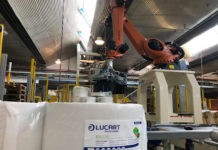The tissue online business is rather limited for the consumer segment and follows the on-line business of groceries. Relatively taken e-commerce is much more common for the AfH sector. Due to the important role of retailers and distributors, distribution in e-commerce is much less of a challenge for the tissue producers than one would think. How is the tissue online business developing and what are the drivers?
General e-commerce is growing globally
The e-commerce, i.e. the on-line shopping value in B2C business in general was expected to reach globally USD 1,8 trillion in 2017. The e-commerce accounts for varying share of the total retail value in different regions. It is expected to reach some 10 % in the US, and it is on11-12% level in China. Online shopping growth rate runs from 40 % in Australia to 9% in North America, in Europe the growth rate is at the 15-14% level and slightly slowing down.
Online sales of groceries are relatively limited; tissue products are purchased together with the groceries
Online tissue sales for consumers are likely to follow similar development as e-commerce of groceries, as these are normally purchased together. Only a small share of the total on-line shopping is groceries. For instance, in Europe from the different categories 34% of clothes and sport sales are made online, 29% of travel and 28% of media and software sales. On line groceries sales share of the total category sales is only some 12 %. In the US, according to some studies 3% of households purchase groceries only online and some 11% sometimes.
Building a grocery business on wheels is very expensive, as food delivery services are logistically very complex. Many are asking, if the Amazon.com’s purchase of Whole Foods Market Inc. will turn grocery delivery business from a niche to the mainstream. The business holds a great potential, as grocery purchases are weekly, therefore this has been pursued by suppliers though many people do not even wish to buy their groceries online.
Among the chief barriers for success is warehousing and distribution. Food needs to be replenished regularly and delivered quickly. Amazon started with Amazon Fresh and further solved these problems with the acquisition of Whole Foods that augments Amazon’s vast network of fulfilment centres with Whole Foods warehouses and 460 stores worldwide.
Whole Foods offers the biggest name in Yuppie groceries and a fleet of urban locations, which can almost double Amazon warehouses. Amazon did not just buy Whole Foods grocery stores. It bought over 400 upper incomes, prime location distribution nodes for everything it does.
The online grocery business is actually very much in the hands or related to existing retail chains. Walmart has booming online sales, Instacart and Shipt act as third party delivery service for food from Publix and Costco.
In Europe, online grocery shopping is also emerging. The UK is the largest market, accounting for 33% of total European e-commerce value while Germany and France are at the 14% level each. Assumingly also the grocery shopping online is biggest in the UK markets. Amazon Fresh, Amazon’s US grocery delivery service, is making entry to the London markets; Prime Now is a smaller scale version of Amazon Fresh. The top online supermarket brand in the UK is Ocado. Also, the large European brick and mortar retailer chains have started their on-line business; Lidl has started on-line grocery delivery and Aldi has an online grocery business, as do most of the others to various extents in various countries.
Many consider the mass home delivery market difficult and are much more positive towards the service that meets consumer in the middle like drive–through, where you can pick up your pre-ordered bag of groceries. The sellers can save the enormous cost and complication of doorstep deliveries. The free pick-up model requires of course a very large store footprint from the retailers.
Tissue e-commerce follows the on-line grocery sales
Though e-commerce is growing, it is not especially fast on groceries. The consumer tissue sales share on-line is expected to be on a similar level or typically on somewhat lower level than that of the on-line groceries. In addition, impact on the tissue producer’s requirements is minor, as the delivery is taken care of by the retailers and the same factors, such as importance of pricing apply. Amazon, Costco etc. offer large size packs, but otherwise similarly brands and private label products as the brick and mortar businesses. From the tissue producer’s and from the delivery perspective, it is not utmost important whether the final consumer buys it from a store or if it’s ordered from the net and delivered from a store.
On-line grocery retailing may be exciting for those who develop it, but it continues to grow at only half the rate of discounters; Aldi and Lidl grow much faster than the top on-line supermarket brand Ocado. On-line business is premium service for those who can afford it. The on-line grocery market grows at only half the rate of number of discounter stores and at a quarter of the rate in cash terms. Consumers still value lower prices over the easiness of home delivery.
Tissue producers’ role
There are very limited direct online sales from a tissue company to consumers. Some specialties like Renova coloured tissues or many napkin providers sell online, but the question is of wellpriced niche business that covers also the delivery costs. By no means does this concern the bulk volumes. Typically, the consumer side of e-commerce is performed by the retailers; either the ones that are focused on e-commerce or the normal chains. The distribution is taken care of by them.
Kimberly-Clark (K-C) has been involved with online marketing for a number of years. Consumers are buying from the retailers, but for instance mobile marketing has a significant role in influencing purchases. K-C is seeing a high level of engagement on mobile devices when people are shopping and using their devices to view reviews and ratings, check prices, etc.
The company is beginning to do more on mobile with regards to partnering with retailers, and they are seeing some nice results in that respect. K-C has launched the Huggies mobile site and continues to evolve the features and functionality. It has experienced that baby products work well on-line. When it comes to the distribution of the products K-C co-operates with Amazon, Walmart, Target etc. K-C’s web site has a link to these retailers’ sites and the purchase happens through these channels. However, tissue paper is much less commonly purchased this way than e.g. diapers. Consumer-side online sales are supported by the brand owner in the on-line marketing and direct connection to the retailer’s site to order. This connection can be very valuable for the tissue producer in terms of information flow from the markets.
Online business in tissue AfH segment
Opportunities in e-commerce are much closer to tissue producers in the AfH side. However, also in AfH the tissue producer sells to the distribution companies and the final sale happens through distributors, janitorial companies, etc. From them the final clients often buy on-line.
The leading AfH suppliers like Essity have established websites to support their AfH marketing. Its global Tork.com website supports the on-line shopping of the final customers from the distributors. Tork has a vast network of distributors and the website supports the clients to understand the full offering of the brand, what is available for different fields of users etc.
In some countries, you can also find on Tork.com distributor lists where you can search which distributors are the nearest, and there is often a link to their sites. From the distributor, online purchases are very common.
Additionally, other suppliers have understood the importance of web marketing in the AfH segment. Sofidel’s Papernet has a great web site explaining their AfH offering. However, the direct relation to product purchasing and the distributors is further away. Sofidel’s AfH business is also much smaller and less global than Tork, but it is also in an emerging stage and Sofidel’s aspiration is to reach similar position with AfH as it has in consumer tissue.
WEPA’s AfH took a quantum leap when the company acquired Van Houtum, the Dutch AfH specialist. WEPA Netherlands has an important AfH brand, Satino Black. Its site supports the distributors with product information and advertising like those of the other leading producers.
In any case, online purchases are closer to tissue producers in the AfH segment. The brand websites increase brand awareness and provide product information. The producer’s online sales support has an important role though the actual online purchase is from the distributors. How big are the online sales in the AfH side? Assumingly a sizable figure of distributor companies will foster that sales channel option for their clients.
In the AfH side a further digitalisation, a service that connects a user’s consumption point directly to the distributor calling automatically for refill, is already near.
For instance, Tork Easy Cube is a service where as an example hand towel or toilet-paper dispensers are followed in real time. The cleaning companies and cleaning managers know where a refill is needed, instead of always going through every point and dispenser.
This is not very far from having the system order refill from the distributor to the client’s warehouse when needed. In AfH, the developments towards sophisticated online solutions are quite likely.
Important also is the information flow the tissue producer has from the new systems. This improves their forecasting and production planning and improves the efficiency of the operations. The forerunners in digitalisation, who get their systems ready first, will have a competitive advantage until everybody else is on the same level.
Is distribution the main challenge for tissue e-commerce?
From the tissue producer’s perspective, distribution is not necessarily very much impacted by e-commerce. Consumer tissue is sold by the retailers that are more or less e-commerce oriented and AfH is sold by the distributor companies.
The actual online purchase and the distribution issues concern only the final seller. In the case of Amazon and other web-retailers and on AfH side of the distributors, a chain of warehouses, stores and fulfilment centres are necessary and from the tissue producers’ perspective is the same how the product is finally sold. Only from the retailer’s perspective is there a difference.
Pӧyry Management Consulting is the leading advisor to players within the global Paper, Pulp, Packaging and Hygiene sector.

































